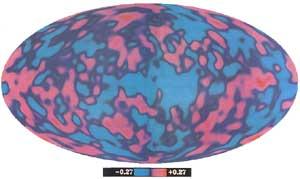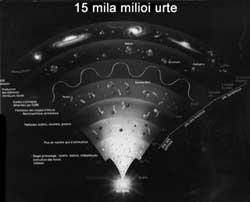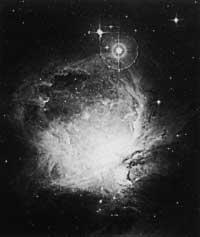COBE satellite and Big Bang theory
COBE satellite data
To clarify the evolution that the universe has had since its creation, for most astronomers there is only a Big Bang theory. According to this theory, almost the entire century, the universe was born fifteen billion years ago with a big explosion. As theoretical evidence has appeared, it has been gaining strength, although there have also been incidents and enemies.
In 1989, on 18 November, the DNA launched the COBE satellite (“Cosmic Background Explorer” or “Explorer of the Cosmo Fund”) to investigate the sky. For a period of time he has sent dubious data, but last year, after collecting more than 300 million observations, he has released results to reinforce the Big Bang hypothesis.

On April 23, the results of the COBE were presented at the American Association of Physicists of Washington. This satellite full of captors measures the radiations of the celestial background, that is, the cosmological radiation. It is the “background noise” of microwave radiation and, in a way, the footprint of the initial explosion.
Microwave background noise
Recording the initial radiation of the universe, the COBE satellite has left astrophysicists worried until last year. Calculations performed at an equivalent radiation temperature (temperature required for the black body radiation to have the same intensity) have been verified. The equivalent radiation temperature is 2,735 Kelvin, which seems to reinforce the Big Bang theory. However, this temperature was very uniform throughout the universe (there were only differences of one hundred degrees) and that uniformity did not benefit the theory. To create galaxies there had to be changes in density so that matter was collected by its weight.
Microwave background noise in the Universe is a trace of the founding fireball and it can be said that it corresponds to an era 300,000 years after the zero moment. At that time, however, the radiation should not be totally uniform. There should be some “flakes” of matter that later became galaxies.
The COBE satellite, therefore, as a consequence of the disturbances in the formation of the universe, had to detect heterogeneities in this microwave radiation, but did not collect it.
The original and current universe

(Note: To see the photo well go to pdf).
The initial universe, unlike the present one, was totally uniform. With eyes or telescopes facing the sky, it is enough to realize that there are now large galaxy structures. Throughout the universe there are a series of galaxies with huge lagoons. We do not know very well how the universe passed from one situation to another, since at the time detected by the satellite, at the time of galaxies or quasars, the gravitation did not have enough time to create the groups of materas that are seen today. Gravitation can form a fairly fast galaxy, but it needs a starting point. The starting point can be a denser materi copo or an exploded irregularity.
Finally, irregularities have been detected. By increasing 10,000 times the measures accumulated by the COBE satellite, small irregularities in the radiation temperature of 30 million degrees have been obtained. According to the researchers, these small irregularities are due to the small differences in density presented by the limit matter of the cosmos. This matter would consist of a huge saliva cloud and lighter gas in the area. The lesser of these cosmic wrinkles would be 500 million light years.
The head of the satellite team COBE, George Smoot, considers that these small irregularities or waves detected in the limit of the universe are small fragments of mates that show us the oldest structures that are somehow known. After the initial explosion they formed immediately and the density of the universe has not been uniform. Gravitation has since worked by concentrating matter and creating stars, galaxies and galaxy sets. These border clouds, therefore, will offer lights on the galaxy formation system.
Big Bang Theory
The Big Bang theory, which says that the Universe suffered a great explosion at first, derives from an equation of the general theory of relativity created by Einstein, although Einstein himself believes in the stationary Universe. Georges Lemaitre of the University of Louvain was the one who in 1927 first published the theory of the “cosmic egg” and the “initial atom”, which would then be the theory of the Big Bang. At that time the American astronomer Slipher discovered that the lines were shifted red in the spectra in the light of the galaxies and it was thought that they could be due to the Doppler effect, that is, to the distance of the galaxies the wavelength was increased. Then the astronomer Hubble drew a constant of proportionality between the speed of distance and the distance between galaxies.
The fact that galaxies moved away today means that at one time they were closer and that all matter in the universe was concentrated at one point. Given the speed of distance the galaxy now has, we can calculate the time it would take to retreat until all matter is attached to that speed. The age of the universe is approximately fifteen billion years.
The universe, therefore, arises from a major explosion, according to the Big Bang theory. George Gamow, a Soviet physicist based in North America, spread the idea of the initial explosion in 1948. He said the universe was like a ball with surface confessions. The more the ball swelled, the more confessions moved away.
Background noise and light elements

Knowing that galaxies moved away from each other, in 1964 the Sres. Penzias and Wilson found another test in favor of the Big Bang theory at the Bell Phone labs in New Jersey. Physicist Robert Dicke detected the background of radiation from the announced sky. Dick pointed out that the footprint of the time when the universe was full of light should remain today as microwave radiation (although the equivalent radiation temperature had dropped to 3K), occupying the entire universe. Like any physical system, as the universe expands it has cooled. Consequently, the radiation was warmer at one time. A million years ago the radiation temperature was about 4,000 K and we cannot detect previous radiation because the ionized gas occupying the space was opaque.
Another test in favor of the Big Bang theory is the abundance of light elements in the universe. You can know which elements existed at the beginning of the universe by analyzing the oldest stars today. The relationship between helium and hydrogen by spectroscopy of these stars coincides with what was announced by the Big Bang theory for thermonuclear reactions immediately after the explosion. In fact, the temperature of the first minutes was so high that other elements, mainly helium, originated from hydrogen.
However, the Big Bang theory is a theory that reveals the first moments of the universe, but does not explain how galaxies and stars were formed in the first billion years. Astronomers believe they know how the universe was born, but they do not know the transformations that have occurred to reach the current situation. There is an unresolved gap so the data sent by the COBE satellite is so interesting.
Buletina
Bidali zure helbide elektronikoa eta jaso asteroko buletina zure sarrera-ontzian











